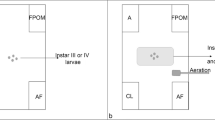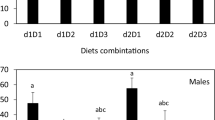Abstract
This study examined larval food habits of two syntopic, related, carabids Amara chalcites Dejean and A. congrua Morawitz using a laboratory-rearing experiment, and the results were compared with those of a previous stable-isotope analyses of the same species. Larvae were reared on six different diets (seeds of Capsella bursa-pastoris (Linnaeus) Medikus, Stellaria media (Linnaeus) Villars, Taraxacum officinale Weber ex Wiggers; mixed seeds; Tenebrio molitor Linnaeus larvae; and Tenebrio larvae + mixed seeds). For both species, beetles fed seed diets exhibited moderate to high survival rates, with the exception of those fed Stellaria seeds, on which A. congrua showed low survival rates. The pure-animal diet resulted in high survival rates of A. chalcites but low survival rates of A. congrua. These results were consistent with those of the isotope analysis, in which A. chalcites larvae were more carnivorous than were A. congrua larvae, and the larvae of the two species appeared to prefer different types of seeds. In contrast, the effect of diet on adult weight differed between the two methods. In the laboratory experiments, supplementing seeds with animal food during the larval stage positively affected adult weight for both species, whereas in the isotope analysis, the positive effect only occurred in A. chalcites. Possible explanations for the discrepancy between the two methods and suggestions for future research are provided.


Similar content being viewed by others
References
Begon M, Harper JL, Townsend CR (1996) Ecology: individuals, populations and communities. Blackwell Science Ltd., Oxford
Brandmayr TZ, Mazzei A, Talarico F, Giglio A, Bauer T, Brandmayr P (2007) The larva of Siagona europaea Dejean, 1826: morphology and collecting technique for a subterranean blind ‘running ant killer’ (Coleoptera, Carabidae). Ital J Zool 74:239–245
Caut S, Angulo E, Courchamp F (2009) Variation in discrimination factors (Δ15N and Δ13C): the effect of diet isotopic values and applications for diet reconstruction. J Appl Ecol 46:443–453
Fawki S, Toft S (2005) Food preferences and the value of animal food for the carabid beetle Amara similata (Gyll.) (Col., Carabidae). J Appl Entomol 129:551–556
Habu A (1977) Discriminating characteristics between Amara (Amara) chalcites Dejean and A. (A.) congrua Morawitz (Coeloptera, Carabidae). Entomol Rev Jpn 30:53–59 (In Japanese with English summary)
Habu A, Sadanaga K (1961) Illustrations for identification of larvae of the Carabidae found in cultivated fields and paddy-fields (II). Bull Nat Inst Agric Sci Ser C 16:151–179 (in Japanese with English summary)
Hebert PDN, Cywinska A, Ball SL, DeWaard JR (2003) Biological identifications through DNA barcodes. Proc R Soc B 1512:313–321
Hieke F (2003) Subtribe Amarina C. Zimmermann, 1831. In: Löbl I, Smetana A (eds) Catalogue of palaearctic coleoptera. Archostemata–Myxophaga–Adephaga, vol 1. Apollo Books, Denmark, pp 547–568
Holland JM (2002) The agroecology of carabid beetles. Intercept Ltd, Andover
Ikeda H, Kubota K, Kagawa A, Sota T (2010) Diverse diet compositions among harpaline ground beetle species revealed by mixing model analyses of stable isotope ratios. Ecol Entomol 35:307–316
Ishitani M (1996) Ecological studies on ground beetles (Coleoptera: Carabidae, Brachinidae) as environmental indicators. Mis Rep Hiwa Mus Nat Hist 34:1–110 (in Japanese with English summary)
Kromp B (1999) Carabid beetles in sustainable agriculture: a review on pest control efficacy, cultivation impacts and enhancement. Agr Ecosyst Environ 74:187–228
Kruse PD, Toft S, Sunderland KD (2008) Temperature and prey capture: opposite relationships in two predator taxa. Ecol Entomol 33:305–312
Kubota K (1998) The seasonal activity changes of carabid beetles at experiment station at Tanashi, The University of Tokyo: with special reference to the reproductive season (Coleoptera, Carabidae). Bull Tokyo Univ For 100:1–11 (In Japanese with English summary)
Lövei GL, Sunderland KD (1996) Ecology and behavior of ground beetles (Coleoptera: Carabidae). Annu Rev Entomol 41:231–256
Luff ML (1974) Adult and larval feeding habits of Pterostichus madidus (F.) (Coleoptera: Carabidae). J Nat Hist 8:403–409
Lundgren JG (2009) Relationships of natural enemies and non-prey foods. Springer Verlag, Dordrecht
McCutchan JH Jr, Lewis WM Jr, Kendall C, McGrath CC (2003) Variation in trophic shift for stable isotope ratios of carbon, nitrogen, and sulfur. Oikos 102:378–390
McKemey AR, Symondson WO, Glen DM (2003) Predation and prey size choice by the carabid beetle Pterostichus melanarius (Coleoptera: Carabidae): the dangers of extrapolating from laboratory to field. Bull Entomol Res 93:227–234
Okuzaki Y, Tayasu I, Okuda N, Sota T (2010) Stable isotope analysis indicates trophic differences among forest floor carabids in Japan. Entomol Exp Appl 135:263–270
Post DM (2002) Using stable isotopes to estimate trophic position: Models, methods, and assumptions. Ecology 83:703–718
Prasifka JR, Lopez MD, Hellmich RL, Lewis LC, Dively GP (2007) Comparison of pitfall traps and litter bags for sampling ground-dwelling arthropods. J Appl Entomol 131:115–120
Sasakawa K, Ikeda H, Kubota T (2010) Feeding ecology of granivorous carabid larvae: a stable isotope analysis. J Appl Entomol 134:116–122
Saska P (2005) Contrary food requirements of the larvae of two Curtonotus (Coleoptera: Carabidae: Amara) species. Ann Appl Biol 147:139–144
Saska P, Jarošík V (2001) Laboratory study of larval food requirements in nine species of Amara (Coleoptera: Carabidae). Plant Protect Sci 37:103–110
Sunderland KD, Lövei GL, Fenlon J (1995) Diets and reproductive phenologies of the introduced ground beetles Harpalus affinis and Clivina australasiae (Coleoptera: Carabidae) in New Zealand. Aust J Zool 43:39–50
Symondson WOC (2002) Diagnostic technique for detecting carabid diets. In: Holland JM (ed) The agroecology of carabid beetles. Intercept Ltd, Andover, pp 137–164
Thiele HU (1977) Carabid beetles in their environment. Springer Verlag, Berlin
Wallin H, Chiverton PA, Ekbom BS, Borg A (1992) Diet, fecundity and egg size in some polyphagous predatory carabid beetles. Entomol Exp Appl 65:129–140
Walrant A, Loreau M (1995) Comparison of iso-enzyme electrophoresis and gut content examination for determining the natural diet of the groundbeetle species Abax ater (Coleoptera: Carabidae). Entomol Gen 19:253–259
Acknowledgments
This study was partly supported by Fujiwara Natural History Foundation and the Japan Society for the Promotion of Science (JSPS) (the Research Fellowship for Young Scientists; no. 20-11227).
Author information
Authors and Affiliations
Corresponding author
Rights and permissions
About this article
Cite this article
Sasakawa, K. Laboratory studies on larval food habits of two syntopic, related, granivorous ground beetles Amara chalcites and A. congrua (Coleoptera: Carabidae): a comparison with stable isotope analysis. Appl Entomol Zool 46, 511–518 (2011). https://doi.org/10.1007/s13355-011-0070-x
Received:
Accepted:
Published:
Issue Date:
DOI: https://doi.org/10.1007/s13355-011-0070-x




